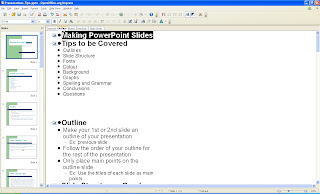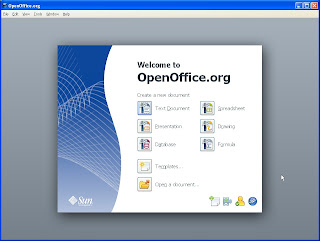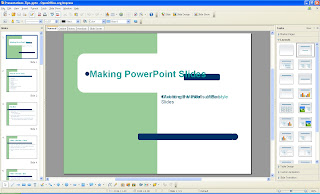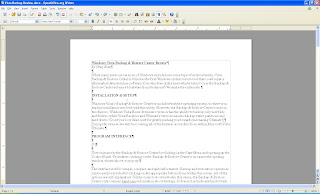
Hello everyone. This is Suhasini here. I am working with People Group which is a group company of companies like Shaadi.com, makaan.com, Astrolife.com, fropper.com and Mauj(Production House) in HR Department as a Recruiter.
I have been using OpenOffice.org which is quite similar to MS Office.
PRODUCT OVERVIEW
OpenOffice is the open-source version of Sun MicroSystems' StarOffice productivity suite, but you'll be forgiven for thinking it looks an awful lot like Microsoft Office 2003. In fact, OpenOffice may feel more
like the MS Office you're used to than Office 2007, as the former has chosen not to emulate the controversial ribbon interface that defines the latest incarnations of MS Office. OpenOffice's pitch is that it can do virtually anything that MS Office does, open any MS Office file (including the docx 2007 versions), and export to any MS Office file type -- but for the best of all possible price points.
OpenOffice is the open-source version of Sun MicroSystems' StarOffice productivity suite, but you'll be forgiven for thinking it looks an awful lot like Microsoft Office 2003. In fact, OpenOffice may feel more
like the MS Office you're used to than Office 2007, as the former has chosen not to emulate the controversial ribbon interface that defines the latest incarnations of MS Office. OpenOffice's pitch is that it can do virtually anything that MS Office does, open any MS Office file (including the docx 2007 versions), and export to any MS Office file type -- but for the best of all possible price points.
Open Office 3.1 includes the Write word processor, the Calc spreadsheet, the Impress presentation creator, the Base database program,and the Draw graphics application. This review will focus on the first three, as that's where most users' office application works is centered, and it's where most MS Office alternatives compete for your software dollars -- even if many of the competitors are available for free.
No licensing fees. OOo is free for anyone to use and distribute at no cost. Many features that are available as extra cost add-ins in other office suites (like PDF export) are free with OOo. There are no hidden charges now or in the future. Open source. You can distribute, copy, and modify the software as much as you wish, in accordance with either of OOo's Open Source licenses

Cross-platform. OOo 2.x runs on several hardware architectures and under multiple operating systems, such as Microsoft Windows, Mac OS X, Linux, and Sun Solaris. Extensive language support. OOo's user interface is available in over 40 languages, and the OOo project provides spelling, hyphenation, and thesaurus dictionaries in over 70 languages and dialects. OOo also provides support for both Complex Text Layout (CTL) and Right to Left (RTL) layout languages (such as Hindi, Hebrew, and Arabic).

Cross-platform. OOo 2.x runs on several hardware architectures and under multiple operating systems, such as Microsoft Windows, Mac OS X, Linux, and Sun Solaris. Extensive language support. OOo's user interface is available in over 40 languages, and the OOo project provides spelling, hyphenation, and thesaurus dictionaries in over 70 languages and dialects. OOo also provides support for both Complex Text Layout (CTL) and Right to Left (RTL) layout languages (such as Hindi, Hebrew, and Arabic).
Consistent user interface. All the components have a similar "look and feel," making them easy to use and master. Integration. The components of OpenOffice.org are well integrated with one another. All the components share a common spelling checker and other tools, which are used consistently across the suite. For example, the drawing tools available in Writer are also found in Calc, with similar but enhanced versions in Impress and Draw. You do not need to know which application was used to create a particular file (for example, you can open a Draw file from Writer).

Granularity. Usually, if you change an option, it affects all components. However, OOo options can be set at a component level or even document level.
File compatibility. OOo includes PDF and Flash export capabilities, as well as support for opening and saving files in many common formats including Microsoft Office, HTML, XML, WordPerfect, and Lotus 123 formats.
No vendor lock-in. OOo 2.x uses OpenDocument, an XML (eXtensible Markup Language) file format developed as an industry standard by OASIS (Organization for the Advancement of Structured Information Standards). These files can easily be unzipped and read by any text editor, and their framework is open and published.
You have a voice. Enhancements, software fixes, and release dates are community-driven. You can join the community and affect the course of the product you use.
You can read more about OpenOffice.org, its mission, history, licensing, and other organizational information here: http://www.openoffice.org/about.html
File compatibility. OOo includes PDF and Flash export capabilities, as well as support for opening and saving files in many common formats including Microsoft Office, HTML, XML, WordPerfect, and Lotus 123 formats.
No vendor lock-in. OOo 2.x uses OpenDocument, an XML (eXtensible Markup Language) file format developed as an industry standard by OASIS (Organization for the Advancement of Structured Information Standards). These files can easily be unzipped and read by any text editor, and their framework is open and published.
You have a voice. Enhancements, software fixes, and release dates are community-driven. You can join the community and affect the course of the product you use.
You can read more about OpenOffice.org, its mission, history, licensing, and other organizational information here: http://www.openoffice.org/about.html



